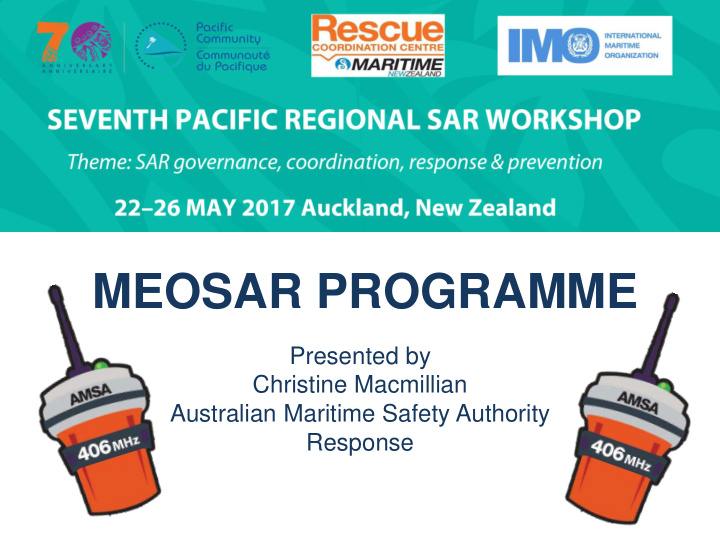



Heading MEOSAR PROGRAMME Presented by Christine Macmillian Australian Maritime Safety Authority Response
Overview What is MEOSAR? Why MEOSAR? How does MEOSAR work? What is the status of MEOSAR? How will MEOSAR affect the Pacific? An incident with MEOSAR data
What is MEOSAR? The Cospas-Sarsat beacon detection system is an international system for beacon detection Current satellite constellations: New satellite constellation: LEOSAR (Low-altitude Earth Orbit MEOSAR (Medium-altitude SAR) Earth Orbit SAR) GEOSAR (Geostationary SAR )
The Cospas-Sarsat System How does the COSPAS SARSAT system work in Australia? 1. Distress beacon activated 2. Signal & HEX ID is transmitted and detected by the nearest satellite overhead 3. Alert sent to nearest LUT 4. Alert is processed by nearest MCC. If registered, registration details are provided to the JRCC in the country in which the beacon is both activated and registered. If the beacon is activated in the Australian SRR, the details are forwarded to AMSA’s JRCC in Canberra. 5. The JRCC is notified and begins to arrange search and rescue operation. If your beacon is registered, AMSA will ring emergency contacts immediately for information regarding your whereabouts. 6. SAR authorities commence search operations as soon as they can.
Why MEOSAR? Reduced time to detect and locate a beacon 95% of beacons detected within 10 minutes with accuracy within 5 kms Better location accuracy (not yet demonstrated in practice)
How does MEOSAR work?
What is the status of MEOSAR? United States and France are only countries currently commissioned by Cospas-Sarsat for MEOSAR. The United States has MEOLUTs at Hawaii and Florida. These MEOLUTs will detect and locate beacons in the Pacific. MEOSAR alerts are being sent to RCCs in addition to current LEOSAR and GEOSAR alerts.
/TO: NCRCC Messages currently /MEOSAR data forwarded by the AUMCC to NCRCC 1. DISTRESS COSPAS-SARSAT UPDATED DOA POSITION MATCH 2. MSG NO. 58344 USMCC REF 32263 being sent by the United 3. DETECTED AT 10 MAY 17 1917 UTC BY MEOSAR 4. DETECTION FREQUENCY 406.0249 MHZ States 5. COUNTRY OF BEACON REGISTRATION 576/VANUATU 6. USER CLASS - EPIRB MARITIME USER ID 519000 7. EMERGENCY CODE - NONE 8. POSITIONS CONFIRMED - NIL DOPPLER A - NIL DOPPLER B - NIL DOA - 04 33.1S 081 12.5W EXPECTED ACCURACY UNKNOWN ALTITUDE 17 METRES ENCODED - NIL 9. ENCODED POSITION PROVIDED BY: NIL 10. NEXT PASS / EXPECTED DATA TIMES CONFIRMED - NIL DOPPLER A - NIL DOPPLER B - NIL DOA - MEOSAR DATA USUALLY SENT WITHIN 5 MINUTES ENCODED - NIL 11. HEX ID C808174334D34D1 HOMING SIGNAL 121.5 12. ACTIVATION TYPE - AUTOMATIC OR MANUAL 13. BEACON NUMBER ON AIRCRAFT OR VESSEL NO. 0 14. OTHER ENCODED INFORMATION BEACON MANUFACTURER AND MODEL - UNKNOWN 15. OPERATIONAL INFORMATION SOURCE (MCC OR USA LUT): 3669/FL-MEO MEOSAR ALERT LAST DETECTED AT 10 MAY 17 1918 16. REMARKS - NIL
Australia-New Zealand collaboration Source: Australia-NZ Cooperative MEOSAR System Ground Segment Report by SSAI (Larry LeBeau) November 2010
Status in New Zealand Six antenna New Zealand MEOLUT in Goudies Road, North Island
Status in Australia Six antenna Australian MEOLUT in Mingenew, Western Australia
How will MEOSAR affect the Pacific? When the Australian/NZ system is commissioned, MEOSAR data will be sent to Pacific countries combined with the existing LEOSAR and GEOSAR data. The New Zealand MEOLUT will provide excellent coverage for the South Pacific.
/00773 00000/5030/17 130 2048 Changes to the 1. DISTRESS COSPAS/SARSAT INITIAL ALERT 2. MSG NO: 00755 AUMCC REF: C808174334D34D1 - 83964 3. DETECTED AT: 10 MAY 2017 2047 UTC BY MEOSAR message to RCCs 4. DETECTION FREQUENCY: 406.025 MHZ 5. COUNTRY OF BEACON REGISTRATION: 576/VANUATU 6. USER CLASS: MARITIME 519000 7. EMERGENCY CODE: N/A 8. POSITIONS: CONFIRMED - NIL DOPPLER A - NIL DOPPLER B - NIL DOA - 04 33.8S 081 14.2W EXPECTED ACCURACY 006 NMS ALTITUDE 16 METRES ENCODED - NIL UPDATE TIME UNKNOWN 9. ENCODED POSITION PROVIDED BY: NIL 10. NEXT PASS / EXPECTED DATA TIMES: CONFIRMED - NIL DOPPLER A - NIL DOPPLER B - NIL DOA - NORMALLY DISTRIBUTED EVERY (15) MINUTES ENCODED - NIL 11. HEX ID: C808174334D34D1 HOMING SIGNAL: 121.5 12. ACTIVATION TYPE: MANUAL 13. BEACON NUMBER ON AIRCRAFT OR VESSEL: 0 14. OTHER ENCODED INFORMATION: NIL 15. OPERATIONAL INFORMATION: NIL 16. REMARKS: NIL
Updates By default, the new MEOSAR system will send updates every 15 minutes. An RCC should expect to receive many more alerts. In a recent incident, the Australian JRCC received 113 MEOSAR messages over 20 hours. The default can be changed to not send updates every 15 minutes.
Preparation in the Pacific See most recent version of Cospas-Sarsat document C/S G.007 “Handbook for RCCs” (www.cospas-sarsat.int in the Documents section).
Questions Do RCCs (PNG, Solomon Islands, Fiji, New Caledonia and NZ) want updates every 15 minutes? How will RCCs forward alerts to relevant authorities?
Timelines December 2016 - USMCC and FMCC sending MEOSAR data July 2017 – AUMCC commissioned, sending MEOSAR data merged with LEOSAR and GEOSAR
An incident with MEOSAR data • 23 April 2017 in NZ. JRCC NZ received MEOSAR alerts for a beacon associated with a group of three trampers (hikers). A rescue helicopter was tasked. One member of the party had an injury requiring hospital treatment. • MEOSAR provided a time advantage of 1 hour and 29 minutes compared with LEOSAR.
Rescue of the “Val” • 40 foot ketch, 200 NM East of Sydney • MEOSAR provided a location 1 hour and 12 minutes before LEOSAR. • 2 persons were rescued after a police rescue vessel travelled overnight to reach the “Val”.
Thank You
Recommend
More recommend